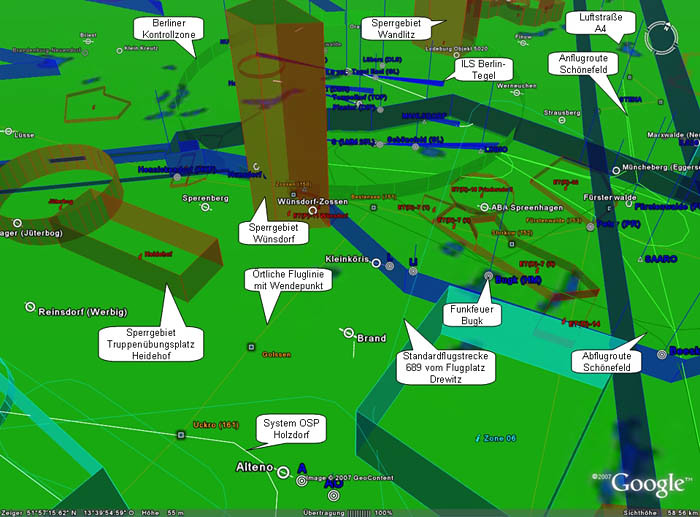A Design History of Military Airspace
This is pretty great: a volumetric rendering of military airspace in East Germany during the 1980s, as imaged in Google Earth. "The air space over the GDR was a complex three-dimensional thing," we read.
 [Image: DDR-Luftraum].
[Image: DDR-Luftraum].
While the very idea of mapping military airspace is fascinating, the historical nature of the above image strikes me as its most provocative aspect. After all, what maps or archives now exist depicting lost military airspace volumes as defined by closed bases, renovated airfields, or no-longer-existing countries?
For that matter, what about the civilian airspace volumes of urban buildings that have since been torn down? How does real estate law account for property transactions based on air volumes for buildings that no longer exist?
How and where—and by what representational means—can these spaces be archived? Could there be an experiential museum of lost airspace volumes, and what atmospheric form might it take?
(Thanks to Nick Sowers for kicking off the idea for this post).
 [Image: DDR-Luftraum].
[Image: DDR-Luftraum].While the very idea of mapping military airspace is fascinating, the historical nature of the above image strikes me as its most provocative aspect. After all, what maps or archives now exist depicting lost military airspace volumes as defined by closed bases, renovated airfields, or no-longer-existing countries?
For that matter, what about the civilian airspace volumes of urban buildings that have since been torn down? How does real estate law account for property transactions based on air volumes for buildings that no longer exist?
How and where—and by what representational means—can these spaces be archived? Could there be an experiential museum of lost airspace volumes, and what atmospheric form might it take?
(Thanks to Nick Sowers for kicking off the idea for this post).





Comments are moderated.
If it's not spam, it will appear here shortly!
http://www.andrew-liebchen.com/no-fly-zone. Audiology and aerial rooms.
Awesome idea for an article! I guess the airspace has changed a lot there since that time. I'm currently finishing up a book by a former pilot from RAF Laarbruch in Germany (now closed), which is really fascinating, so was pretty coincidental to open up BLDG Blog and see this! Interesting stuff, cheers.
Andrew, thanks! Interesting ideas, as always.
Tom, what is the name of the book you just finished reading?
I guess these no-fly zones and air routes must have been gazetted by the various civil aviation authorities, and that information would still be retrievable (with work). I wrote a post a few years back about early (1913) British regulations concerning airspace, here:
http://airminded.org/2007/03/16/air-port-13/
Because they were then so novel, they were published in all the newspapers!
if you haven't seen it already, you might like this...Regine Debatty recently reviewed the new "Airspace Activism" exhibit. The review was posted at Worldchanging on 6/24:
http://www.worldchanging.com/archives/011320.html
Post a Comment